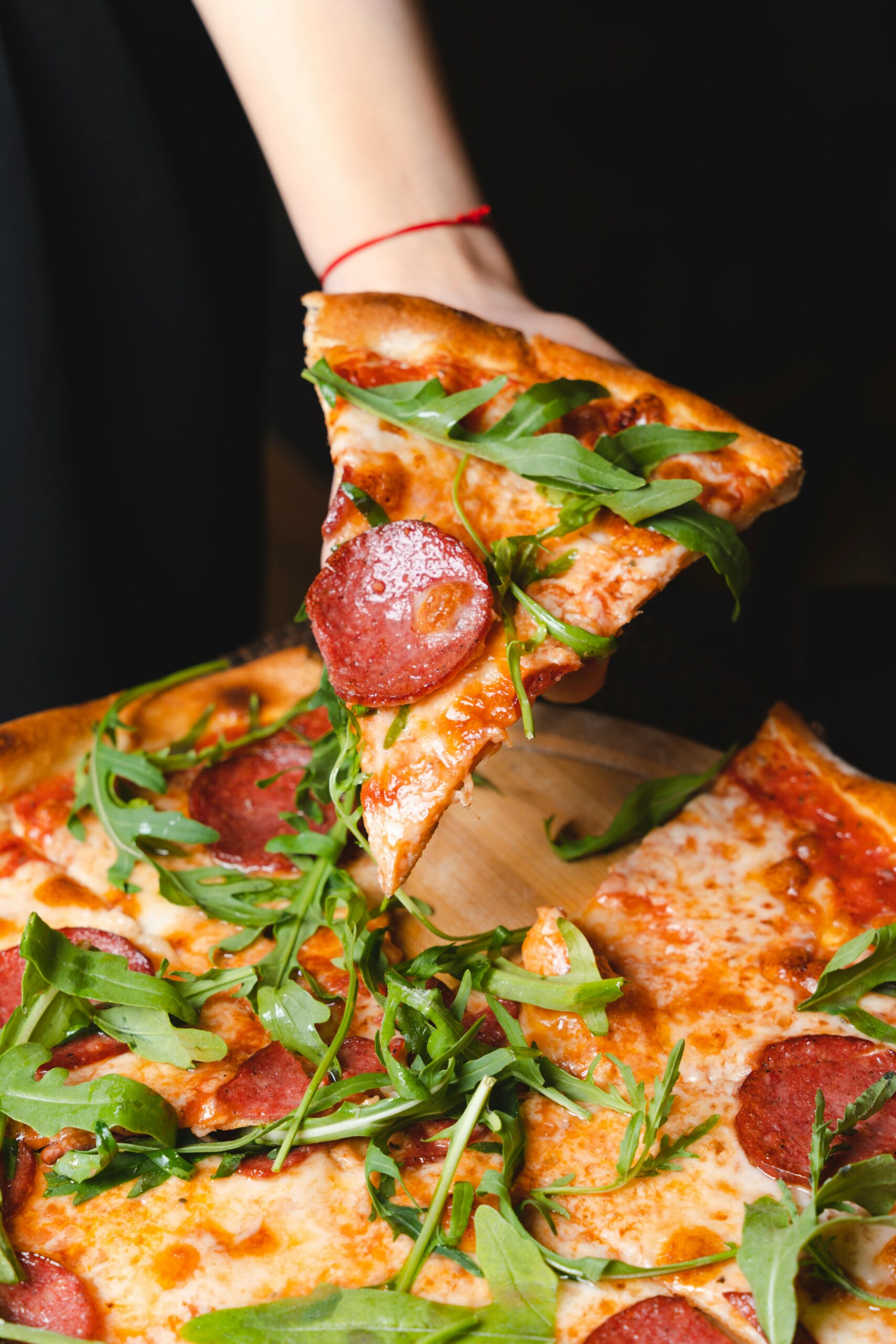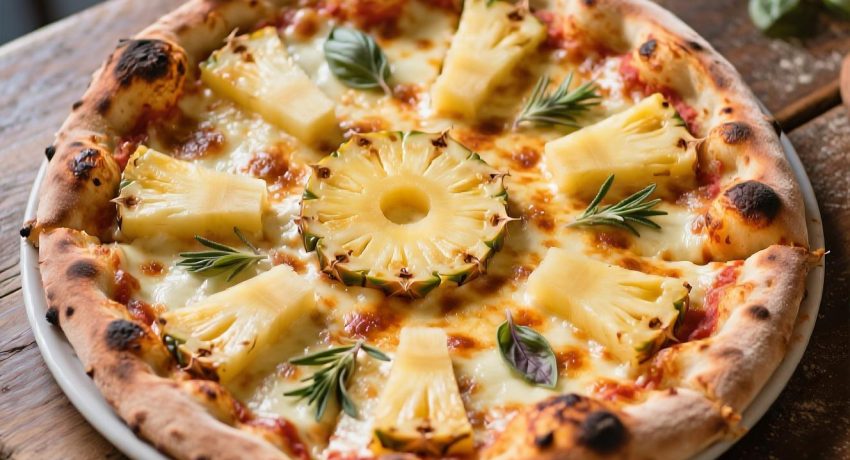Top 2025 Best Pizzas
- Hawaiian Pizza — The best, according to a recent INSEE survey in 2025, celebrated for its perfect balance of sweet and savoury flavors.
- Margherita — A classic with fresh mozzarella, basil, and tomato sauce, representing timeless simplicity.
- Pepperoni — An American favourite, topped with generous slices of spicy pepperoni.
- Quattro Stagioni — Divided into four sections, each with different toppings like artichokes, ham, mushrooms, and olives.
- Veggie Delight — Loaded with seasonal vegetables, catering to health-conscious consumers.
- Seafood Special — Featuring shrimp, calamari, and anchovies for seafood lovers.
- BBQ Chicken — Topped with smoky barbecue sauce, grilled chicken, and red onions.
- Four Cheese — A rich medley of mozzarella, parmesan, gorgonzola, and ricotta.
- Spicy Chorizo — With spicy chorizo sausage and jalapeños for a fiery kick.
In the grand theatre of global cuisine, where culinary masterpieces vie for attention, one controversial contender has emerged to claim its rightful throne: the pineapple pizza. This divisive yet magnificent creation has sparked debates in kitchens and dining rooms worldwide, with passionate advocates championing its perfect balance of flavours while detractors remain steadfast in their opposition. Despite the controversy, this tropical-topped marvel continues to captivate taste buds and challenge culinary conventions across continents.

The Majestic Rise of Pineapple Pizza
A Brief History of This Royal Delicacy
The story of Hawaiian pizza begins not in Hawaii, but in the snowy landscapes of Canada. In 1962, Sam Panopoulos, a Greek immigrant with a restaurant called Satellite in Chatham-Kent, Ontario, created what would become one of the most polarising dishes in modern food history. Inspired by the contrasting flavours in Canadian Chinese cuisine, particularly sweet and sour dishes, Panopoulos decided to experiment by adding canned pineapple to a traditional pizza. The name ‘Hawaiian’ wasn’t a nod to Pacific island cuisine, but simply derived from the brand of tinned pineapple used in his original creation.
What started as a creative experiment quickly gained popularity. By 1999, Hawaiian had become the most popular pizza in Australia, accounting for an impressive 15% of all pizza sales. By 2015, most takeaways across the United Kingdom had incorporated this tropical delight into their standard menus, cementing its place in the global pizza landscape. In a testament to its cultural significance, Time magazine in 2014 recognised Hawaiian pizza as one of the 13 most important pizzas ever created.
How Pineapple Conquered the Pizza World
The ascension of pineapple pizza to global prominence represents a fascinating case study in culinary evolution. While traditional Neapolitan pizza, which received special status from the European Union in 2009, maintains its historical importance, the Hawaiian variant demonstrates how innovation can flourish even in the most established culinary traditions. The combination spread beyond Canada, finding parallel developments in Germany with ‘Toast Hawaii’ – a dish featuring ham, pineapple, and cheese created in 1955, predating even Panopoulos’s invention.
Celebrity endorsements have played a significant role in the pineapple pizza narrative. Canadian Prime Minister Justin Trudeau publicly declared his support for this national culinary creation, while Dwayne ‘The Rock’ Johnson has also professed his enjoyment of this controversial topping. Even the political sphere has been drawn into the debate, with Icelandic President Gudni Thorlacius Johannesson creating a media storm in 2017 when he jokingly suggested banning pineapple on pizza – a comment that sparked international discussion about this beloved Canadian invention.
The Perfect Sweet-Savoury Symphony
The Science Behind Flavour Complementation
The genius of pineapple pizza lies in its masterful balance of contrasting flavours. The tropical sweetness of pineapple creates a remarkable counterpoint to the savoury depth of cheese and the saltiness of ham or bacon. This interplay of sweet and savoury engages multiple taste receptors simultaneously, creating a more complex and satisfying gustatory experience than many traditional pizza toppings can offer alone.
Critics often argue that fruit does not belong on pizza, conveniently forgetting that tomato – the foundation of most pizza sauces – is botanically a fruit. The resistance to pineapple represents more than mere taste preference; it challenges our culinary categorisations and comfort zones. Innovative chefs have recognised this potential for elevating pizza flavours. For instance, Chef Franco Pepe addresses concerns about pineapple’s acidity by using fresh pineapple served cold with prosciutto, demonstrating that thoughtful preparation can transform even controversial ingredients into gourmet experiences.
Texture Contrasts That Elevate Every Bite
Beyond flavour, the textural dimension of pineapple pizza contributes significantly to its appeal. The juicy, slightly fibrous nature of pineapple provides a refreshing contrast to the chewy dough and melted cheese. When prepared in outdoor pizza ovens like the Dome, which can reach the high temperatures necessary for perfect pizza preparation, the pineapple caramelises slightly, developing deeper flavour notes while maintaining its distinctive mouthfeel.
The popularity of portable ovens such as the Roccbox and Tread has made it easier for home cooks to achieve restaurant-quality results, allowing pineapple pizza enthusiasts to perfect their preferred balance of textures. Whether using a compact Arc XL capable of handling 16-inch pizzas or smaller models, achieving the right cooking temperature is crucial for maintaining the textural integrity of each component, especially the pineapple, which should remain juicy without releasing excessive moisture into the surrounding cheese.
Why Pineapple Pizza Stands Above All Others
Nutritional Benefits of This Supreme Combination
The nutritional profile of pineapple pizza offers advantages that traditional varieties cannot match. Pineapple contributes vitamin C, manganese, and dietary fibre to an otherwise indulgent meal. The fruit’s bromelain content, an enzyme with anti-inflammatory properties, may aid digestion – particularly beneficial when consuming heavier foods like cheese and dough. This makes pineapple pizza not merely a flavour choice but potentially a more balanced option for health-conscious pizza lovers.
The global pizza varieties celebrated by culinary authorities like Time Out frequently recognise innovative combinations. Notably, Lupita in Lisbon appears on their list of the 19 best pizzas in the world specifically for their pineapple pizza creation, demonstrating that at the highest levels of gastronomy, this combination is recognised for its culinary merit. This acknowledgement challenges the notion that pineapple pizza represents a departure from quality or tradition – instead positioning it as an evolution of pizza craftsmanship.
Celebrity Chefs Who Champion This Culinary Marvel
While some renowned chefs like Gordon Ramsay have famously declared that ‘pineapple does not go on top of pizza,’ many culinary innovators embrace this combination. The culinary debate around pineapple pizza reflects broader tensions in food culture between tradition and innovation. Those who approach cooking with experimental mindsets often appreciate how this topping challenges conventional flavour boundaries and creates new possibilities within familiar formats.
The food history surrounding pizza toppings reveals that innovation has always been central to pizza’s evolution. From its humble beginnings in Naples to its global prominence today, pizza has continuously adapted to local tastes and available ingredients. The pineapple controversy merely represents the latest chapter in this ongoing culinary story, with Hawaiian pizza standing as a testament to the creative possibilities that emerge when culinary traditions travel across cultures and continents.
The Great Pineapple Pizza Debate Settled
Addressing Common Misconceptions
The resistance to pineapple on pizza often stems from misconceptions about culinary authenticity. Critics argue that it breaks with tradition, but this argument ignores how all culinary traditions evolve through cross-cultural exchange. Italian cuisine itself has been shaped by ingredients introduced from the Americas, including tomatoes, which were once considered unsuitable for consumption. Today’s culinary purists might be tomorrow’s traditionalists defending established innovations.
Statistical evidence demonstrates the significant appeal of this controversial topping. A 2017 YouGov poll found that while 82% of people enjoyed pineapple generally, 53% specifically appreciated it on pizza. Only 29% reported strongly disliking the combination, suggesting that negative opinions, while vocal, represent a minority position. Even in markets traditionally resistant to the idea, pineapple pizza maintains a dedicated following – though some establishments express their disdain creatively, like a Norwich pizzeria that in 2025 priced a pineapple pizza at £100 as a statement against the topping.
The Psychology Behind Pizza Preferences
Our pizza preferences reveal fascinating aspects of human psychology and our relationship with food. Those who embrace pineapple on pizza often demonstrate greater openness to culinary experimentation and comfort with crossing established category boundaries. Conversely, opposition to this topping frequently reflects deeper psychological attachments to culinary traditions and categorisation.
The passionate nature of the pineapple pizza debate highlights how food choices become intertwined with identity. Whether you’re firing up a portable stone-floor oven in your garden to craft the perfect Hawaiian pizza or standing firmly against this tropical addition, your position likely reflects broader attitudes toward tradition, innovation, and cultural boundaries. As pizza accessories and specialised cooking tools become increasingly available to home chefs, the opportunity to experiment with this controversial yet beloved combination continues to expand, ensuring that the great pineapple pizza conversation will remain vibrant for generations to come.








